Reply To:
Name - Reply Comment

Senaka Senanayaka - Oil on canvas of people hard at work ploughing a field with tractors, bulls and manual tools (1975)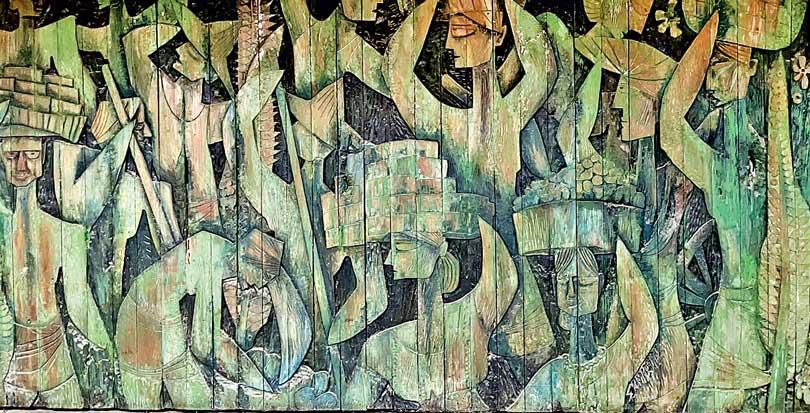
Wood carving by Upasiri 1977 of various forms of manual labour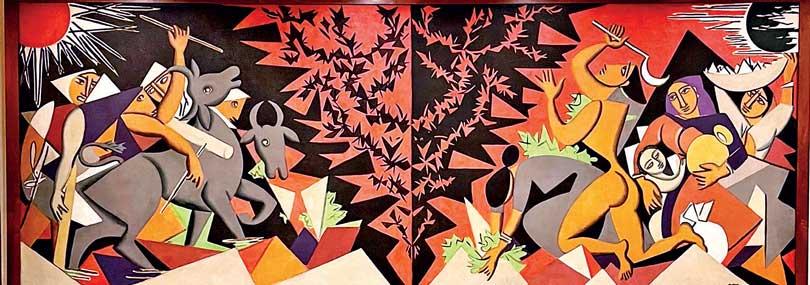
George Keyt 1976 Oil on Canvas Workers and field animals with the symbolic sickle sowing
and harvesting. The painting has red and black abstract center fold iconic of the Soviet style
 Nestled amidst the bustling streets of Slave Island lies an obscure Art Gallery that remains largely unknown to the public. The building, a stark relic of Sri Lanka's socialist era in the 1970s, is frequented by hundreds of locals conducting routine banking tasks, unaware of its historical significance and the treasure trove of art it houses. The People's Bank Building, located at Sir Chitthampalam Gardiner Mawatha, was completed in 1976 during Mrs. Sirimavo Bandaranayake's second term as Prime Minister. Constructed in an era of stringent import restrictions, the building was a testament to the utilization of local materials and decorations. The collaborative efforts of the SLFP and the Communist party under Mrs. B's coalition government led to its commission, with the State Engineering Corporation overseeing the construction while the interior design was coordinated by Suren Wickremasinghe and his Russian-born wife, Tanya. Although completed during Felix Dias Bandaranaike's tenure as Finance Minister, it is likely that the project was initiated before 1975 when Dr. N.M. Perera of the Communist party held that role.
Nestled amidst the bustling streets of Slave Island lies an obscure Art Gallery that remains largely unknown to the public. The building, a stark relic of Sri Lanka's socialist era in the 1970s, is frequented by hundreds of locals conducting routine banking tasks, unaware of its historical significance and the treasure trove of art it houses. The People's Bank Building, located at Sir Chitthampalam Gardiner Mawatha, was completed in 1976 during Mrs. Sirimavo Bandaranayake's second term as Prime Minister. Constructed in an era of stringent import restrictions, the building was a testament to the utilization of local materials and decorations. The collaborative efforts of the SLFP and the Communist party under Mrs. B's coalition government led to its commission, with the State Engineering Corporation overseeing the construction while the interior design was coordinated by Suren Wickremasinghe and his Russian-born wife, Tanya. Although completed during Felix Dias Bandaranaike's tenure as Finance Minister, it is likely that the project was initiated before 1975 when Dr. N.M. Perera of the Communist party held that role.
The building's cold concrete and cement façade serve as a poignant reminder of an era dominated by socialist ideologies, which influenced governmental reforms and policies. Though recent refurbishments have transformed the entrance lobbies, the stairwells retain their original austere appearance, reminiscent of that grim period. However, hidden within this somber edifice are twelve large artworks in various media, adorning the lobby wall of each floor. These creations were crafted by acclaimed artists of the time, including George Keyt and Richard Gabriel from the renowned '43 Group. Young talents like Senaka Senanayaka, Jayantha Premachandra, Nadine David, and others contributed murals using locally available materials such as terracotta, wood, and clay. One of the prominent pieces is architect Ismeth Raheem's mural, illustrating the history of currency in Sri Lanka, featuring aluminum and gold leaf work he learned from Donald Friend, who experimented with these materials during his time in Ceylon. According to Mr. Raheem, it was Pieter Keuneman, a leading member of the Communist party, the then Minister of Housing and Construction, who invited him to contribute a work of art for which he received a fair sum. Throughout the collection, the symbols of the farming and working class—the hammer and sickle—make recurring appearances in paintings by George Keyt, Senaka Senanayake, and Richard Gabriel. Notably, during that era, many architects resorted to clay and terracotta due to their local availability, making it no surprise that these materials were extensively incorporated into the building's design.
Slave Island, one of Colombo's oldest areas, is rapidly losing its multi-ethnic, secular identity as historic colonial buildings fall prey to the Urban Development Authority's demolition plan. The burgeoning office and apartment projects replacing these structures are engulfing neighborhoods, erasing their historical charm and significance. In 2021, Prime Minister Mahinda Rajapakse ceremoniously announced the construction of the new People's Bank Building when the foundation stone was laid for a towering 23-story structure. As for the current location, its fate remains uncertain, with speculation that it might be demolished and sold, along with other state-owned land in Slave Island and Fort. Any plan to relocate these valuable works of art must be approached with utmost care and consideration due to their delicate nature. The clay and terracotta murals are particularly fragile, as they are firmly fixed to the wall.
This rare collection of socialist-era art at the People's Bank Building serves as a silent witness to a pivotal period in Sri Lanka's history, preserving artistic expressions and ideologies that played a vital role in shaping the nation. Uncovering and appreciating this hidden treasure can offer visitors a unique glimpse into the past while fostering a deeper connection to the country's rich cultural heritage.
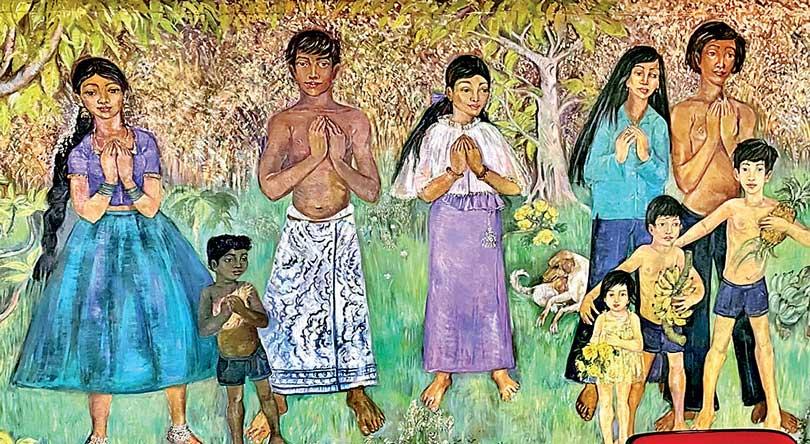
Nadine David Oil on Canvas showing working class people from different ethnicities in harmony and devotion (1976).

Jayantha Premachandra oil on cement mural of industrialization and collective harmonious economic bounty
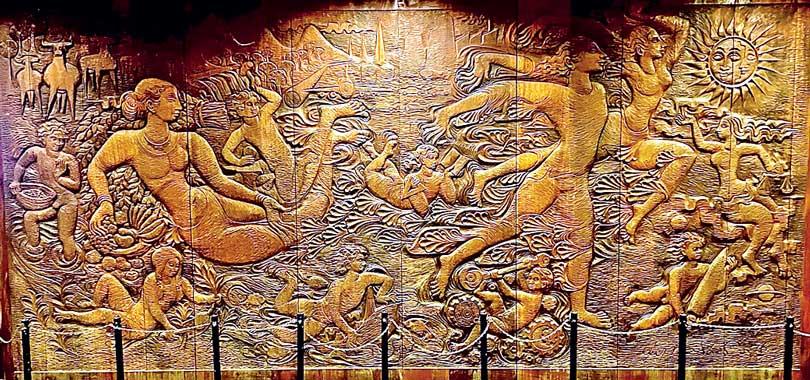
Wood carving by Pushpananda Weerasinghe 1976 of traditional men and women engaged in productive tasks spanning agriculture, industry, music, captured in fluid motion
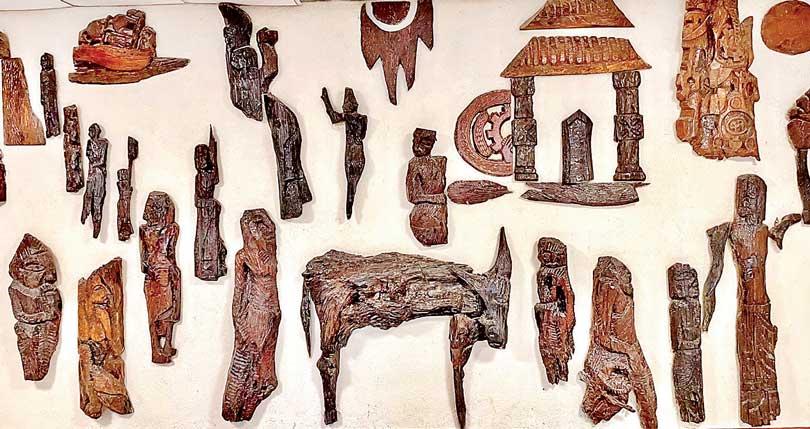
Wood carving by Yasantha Buwange of workers, animals and working class tools